While the stock market was sinking in September, we were soaring . . . with the invitation by very close friends to spend a week at a villa in the South of France. All that was required of us was to get there. Flush with this good fortune, we decided to leave a few days early to spend some time in Nice, the city that inspired Chagall, Matisse, Rossini and Nietzsche.
We, too, wanted to be inspired . . . for restaurant recommendations. So we turned to Michelin, TripAdvisor, Yelp and any other source we could unearth. The search brought us to Restaurant JAN, on the outskirts of the Old City. JAN is a relatively new restaurant (2013) that offers a single 5 course menu, served by a professional staff in an unpretentious, urbane dining room. Just what we were looking for. Here’s how it came down.
We opted for dinner paired with their wine selections. For this first offering, a vegetable course, the dry Riesling from Alsace worked beautifully, serving up peach, apricot, minerality and just enough acidity to stand up to the pickled vegetables in the dish. The pickled vegetables were paired with a carrot “marshmallow”, fennel and snap peas over walnut “soil”; the dish was then garnished with balsamic “pearls”. I know, the text is a little heavy on the use of quote marks, but I didn’t want you to take JAN’s words literally. The bottom line was that the Riesling paired superbly with all the components of this refreshing 1st course.
A terrine of Coppa ham and artichokes appeared next, served with basil & spinach purée, and topped with fresh peas, garlic chips and parmesan foam. Artichokes are usually challenging for wine pairing because they contain an acid called cynarin, which makes everything taste sweet afterwards. In this dish, however, the cynarin was pushed to the background by the Coppa, the pasty dough, and basil puree. The Chardonnay from St-Véran, Domaine de la Croix Senaillet 2013, was a very good choice for this course (and the next). If you’ve never heard of St-Véran, it is a subregion that borders Pouilly-Fuissé in southern Burgundy. This St-Véran is from the northern part of the region (near Davayé), where limestone soils give the wines a distinctive lusciousness and mineral edge. If you are unable to find the Senaillet, you should seek out the St-Vérans of Domaine des Deux Roches, an excellent producer also from this area.
Grilled seabass followed, served in a smoked tomato broth, with roasted tomatoes and a salsa of tomatoes and onions. The garnish that looks like a Hershey’s Kiss was called “tomato air”. I likened this to a tomato mousse – a nice textural contrast to the tomato variations in the dish. The acidity of the St-Véran complemented the acidity of the broth, while the creamy citrus of the wine worked well with the grilled fish. Nice!
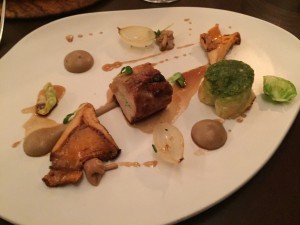 Guinea hen was the headliner, presented both stuffed and confit, with sautéed and pickled wild mushrooms, a mushroom pie and a red fruit tea jus. The Sommelier chose a Bordeaux from Chateau Poitevin 2011 in Central Medoc, a blend of Cabernet Sauvignon and Merlot.
Guinea hen was the headliner, presented both stuffed and confit, with sautéed and pickled wild mushrooms, a mushroom pie and a red fruit tea jus. The Sommelier chose a Bordeaux from Chateau Poitevin 2011 in Central Medoc, a blend of Cabernet Sauvignon and Merlot.
 The choice surprised me initially, as I thought the wine might be too heavy for the hen. But the Poitevin was a fine pairing with the dish. It was an approachable, fruit forward, uncomplicated wine that allowed the dish to take center stage. Left to me, however, I would have paired this course with an earthy, mid-weight Cabernet Franc from Chinon to complement both the subtle gaminess of the hen as well as the mushrooms.
The choice surprised me initially, as I thought the wine might be too heavy for the hen. But the Poitevin was a fine pairing with the dish. It was an approachable, fruit forward, uncomplicated wine that allowed the dish to take center stage. Left to me, however, I would have paired this course with an earthy, mid-weight Cabernet Franc from Chinon to complement both the subtle gaminess of the hen as well as the mushrooms.
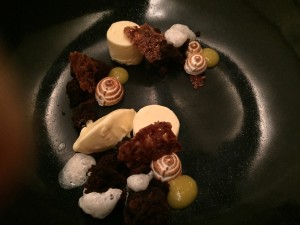 The dessert course featured a rich, vanilla parfait, a small piece a chocolate cake and a quenelle of orange sorbet. The dish was garnished with orange gel, toasted meringue and chocolate & caramel crisps. I usually pass on dessert, but the wine offered convinced me to not stray.
The dessert course featured a rich, vanilla parfait, a small piece a chocolate cake and a quenelle of orange sorbet. The dish was garnished with orange gel, toasted meringue and chocolate & caramel crisps. I usually pass on dessert, but the wine offered convinced me to not stray.
 The course was paired with Coteaux de L’Aubance 2010, a white, sweet wine made from Chenin Blanc grapes. The wine was crafted by Domaine Bablut, a producer from the Anjou district in the Loire Valley. A terrific pairing, with the wine delivering a honeyed, creamy finish, with aromas of peach, pineapple and grapefruit. I love these sweet Chenin Blancs because they aren’t heavy and cloying like some Sauternes can be. If your taste parallels mine, seek out a Quarts de Chaume, the Loire’s first official Grand Cru, offering the perfect balance of acidity and sweetness.
The course was paired with Coteaux de L’Aubance 2010, a white, sweet wine made from Chenin Blanc grapes. The wine was crafted by Domaine Bablut, a producer from the Anjou district in the Loire Valley. A terrific pairing, with the wine delivering a honeyed, creamy finish, with aromas of peach, pineapple and grapefruit. I love these sweet Chenin Blancs because they aren’t heavy and cloying like some Sauternes can be. If your taste parallels mine, seek out a Quarts de Chaume, the Loire’s first official Grand Cru, offering the perfect balance of acidity and sweetness.
Restaurant JAN was all that we hoped it to be: creative courses, thoughtful wine pairings, and a professional, engaging staff. It was an inspired evening.
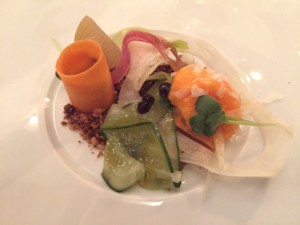
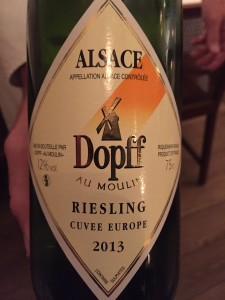
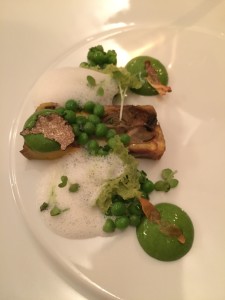
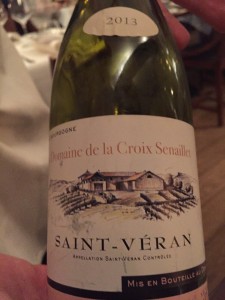
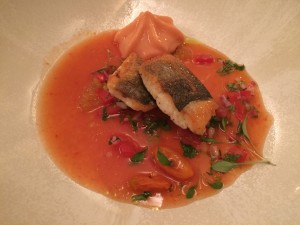
Leave a Comment